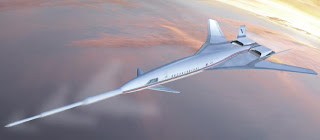Final Presenters for the Aeronautics Student Forum Summer 2009 (at NASA Langley)
Aerodynamics: Hypersonics
Student: Thomas Lambert, Senior, Carnegie Mellon University
Mentor: Victor Lessard, Aerothermodynamics BranchThe objective of this project is to explore a computational fluid dynamics (CFD) overset meshing technology to study surface heating augmentation caused by cavities on the heat shield of the Crew Exploration Vehicle (CEV) at hypersonic speeds. This project will utilize a combination of PSU Applied Research Laboratory overset codes, SUGGAR and DiRTlib, along with NASA’s Fully Unstructured Navier-Stokes flow code, FUN3D to explore the validity of overset unstructured meshes for aerothermodynamic calculations at hypersonic speeds. Computed aerodynamics and aeroheating results, utilizing different types of overset unstructured meshes, will be compared with calculations carried out by NASA’s LAURA code on a non-overset structured grid system.
The Propulsion-Airframe Integrated Scramjet: Access to Space
Students: Melissa Street, Junior, Washington State University
Andrea Dickason, Junior, University of North Dakota
Mentor: Troy Middleton, Hypersonic Airbreathing Propulsion Branch,Currently, propulsion-airframe integrated scramjets are one of the most promising airbreathing propulsion systems for access to space. Integration of the propulsion system with the airframe of the vehicle uses the forebody surface of the airframe to direct the airflow into the scramjet engine. The air ingested by the engine is then reacted with fuel in the scramjet combustor and exhausted along the aft-body of the airframe, creating thrust. This presentation will discuss some of the key components of the scramjet engine, the capabilities and limitations of the scramjet engine, and the current state of the art in scramjet propulsion.
Materials Research: Boron nitride nanosheets
Student: Tiffany Williams, Graduate Student, Cornell University
Mentors: Dr. John Connell, Dr. Yi Lin
Advanced Materials and ProcessingThis project is concerned with the synthesis and characterization of bimetallic nanoparticle decorated carbon nanotubes and the formation of hexagonal boron nitride nanosheet dispersions in various solvents. Characterization via various microscopic and spectroscopic methods will provide information about the morphological, physical, and chemical properties of these materials. These materials are anticipated to exhibit unique combinations of mechanical, electrical, and thermal properties, which would render them useful for potential aerospace applications.
Joint Project: Using sramjet technology for space access
Students: Chris Acuff, Junior, Mississippi State University
Kelcy Brunner, Junior, South Dakota School of Mines and Technology
Rita Groetz, Senior, University at Buffalo
Catherine Patrick, Senior, University of South Dakota
Mentors: Dr. Elizabeth Ward and Mr. Guy Kemmerly
Aeronautics Research Directorate & Science DirectorateWith the successful flight of the X-43A scramjet at Mach 9.6 in 2004, the conceptualization of hypersonic air-breathing vehicles as a method of transportation proceeds closer to feasibility. To study the potential of scramjets, the engineering and scientific implications of scramjet use as a method of space access were explored by looking at a two-stage to orbit scenario. The chosen mission uses a preconceived reference vehicle to carry a payload into low earth orbit. Attention was focused on performing a variable weight analysis of the scramjet portion of the flight in MATLAB, studying the combustion chemistry and extrapolating the atmospheric effects associated with scramjet travel in the upper stratosphere.
Concept studies for UAV VTOL
Student: Guillermo Costa, Junior, California State Polytechnic Institute & University, Pomona
Mentor: William Fredericks, Systems Analysis Branch
Student partner in the project: Alison Snyder, Junior, Ohio State UniversityTwo concept studies of a new unmanned aerial vehicle (UAV) for Project Reimar have been created. The design mission for these vehicles calls for both long endurance and vertical takeoff and landing (VTOL) capability. To aid in performing these design studies a parametric, component-based modeling software called Vehicle Sketch Pad (VSP) was utilized. This software’s key attribute is its ease of use, which greatly reduced many of the labor-intensive modeling practices found in other CAD packages and allowed for rapid design iterations after initial analyses were completed. The concepts were base-lined against similar existing UAVs, including the MLB V-Bat and the AeroVironment Skytote. Maintenance and operation (M&O) costs for each of the Reimar concepts are calculated and compared against existing UAVs with similar payload
Exploring the use of carbon nanotubes for Vertical Takeoff and Landing (VTOL) Unmanned Aerial Vehicles
Student: Kevin R. Antcliff, Sophomore, Virginia Polytechnic Institute and State University
Mentor: Mark Moore, Systems Analysis Branch
Materials made of carbon nanotubes have been of interest to many scientists because of their
remarkable characteristics. It is stiff, flexible and extremely elastic. These three characteristics make it an incredible candidate for a perfect spring that can store astonishing amounts of energy, i.e. Carbon Nanotube Springs (CNS). Current research efforts have included a literature search, interviews with technology experts, and development of the foundational objectives and approaches for investigating this use of CNS for aerospace applications. Initial efforts have been guided by understanding past attempts at achieving jump capability in insect, bird, mammal, and aircraft (yes, even aircraft have attempted to mimic nature through jumping behavior). Application analysis continues in small Unmanned Aerial Vehicles, capable of Vertical Takeoff and Landing (VTOL) through new methods of design integration using this tremendous new technology
Advertising
Trading Futures
Nano Technology
Netbook Technology News
Computer Software
Future Predictions

Brian Wang is a Futurist Thought Leader and a popular Science blogger with 1 million readers per month. His blog Nextbigfuture.com is ranked #1 Science News Blog. It covers many disruptive technology and trends including Space, Robotics, Artificial Intelligence, Medicine, Anti-aging Biotechnology, and Nanotechnology.
Known for identifying cutting edge technologies, he is currently a Co-Founder of a startup and fundraiser for high potential early-stage companies. He is the Head of Research for Allocations for deep technology investments and an Angel Investor at Space Angels.
A frequent speaker at corporations, he has been a TEDx speaker, a Singularity University speaker and guest at numerous interviews for radio and podcasts. He is open to public speaking and advising engagements.


